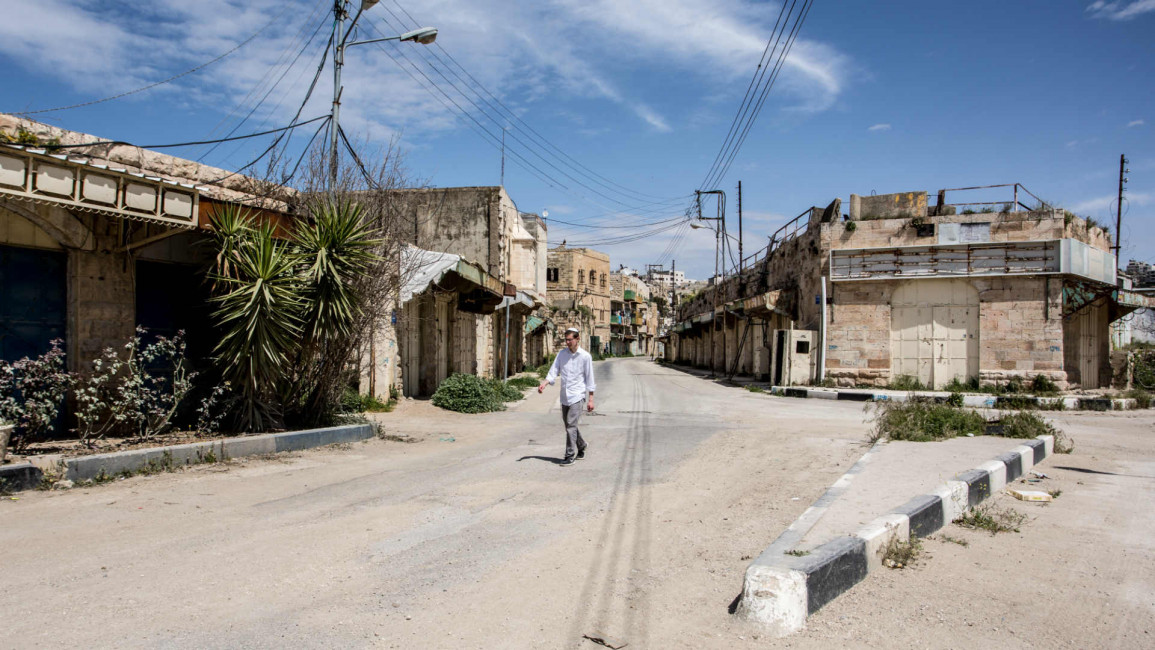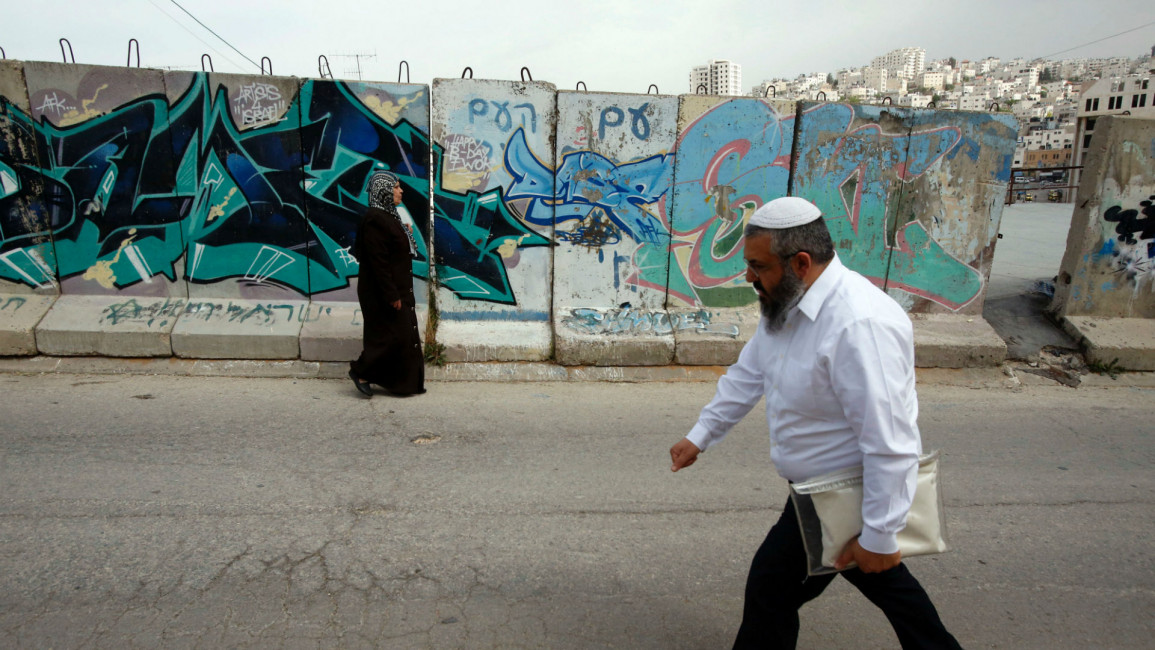
Hebron: A microcosm of Israel's occupation of Palestine

Hebron’s most explosive site, the Ibrahimi Mosque, known as the Cave of the Patriarchs by Jews, was the destination for Israeli President Isaac Herzog to mark the Jewish Holiday of Hanukkah in November.
Herzog, a former leader of Israel’s Labour Party and a supporter of the two-state solution, entered the religious site under the protection of a sizeable armed escort accompanied by leaders of the settler movement.
Palestinians and Israeli left-wing activists who gathered in the area to protest the visit, as well as journalists, were prevented from coming near the site.
Herzog’s visit invited an array of condemnations from Palestinians, Israel’s left, and certain actors in the international community.
Palestinian Prime Minister Mohammad Shtayyeh accused the Israeli president of attempting “to distort the truth about the Arab and Islamic city, to Judaise and control it while subjecting its indigenous population to racist rule.”
"Since 1967, Hebron's complexities have incrementally turned the city into a miniature version of Israel's military occupation of Palestine"
Hamas, meanwhile, had called on Palestinians to counter Herzog’s visit, calling it “provocative and a stark violation of the sanctity of the Ibrahimi mosque.”
The Arab League, the Organisation of Islamic Conference (OIC), and several Arab and Muslim countries - including Jordan and Saudi Arabia - decried the visit as provocative.
Violent peace
In a similar fashion to Ariel Sharon’s visit to Al-Aqsa Mosque in 2000, which ignited the Second Intifada, Herzog painted the Hebron visit in apolitical terms: to serve moral values and promote interfaith relations.
“We must remember that we are not the only ones whose roots branch out from this tomb… in this site sacred to all Children of Abraham – we must continue to dream about peace between all religions and faiths in his land, and to denounce all forms of hatred and violence,” he said.
He went on to emphasise the Jewish people’s Biblical connection to Hebron, saying the Jewish attachment to the city is “beyond debate.”
He spoke about the 67 Jewish victims of the 1929 riots who were killed by Palestinians - over rumours of plans to seize Jerusalem’s Al-Haram Al-Sharif, or Temple Mount. At the time, Hebron’s small Jewish community of 700-800 residents was largely made up of Sephardic Jews who had lived in Palestine for hundreds of years, as part of the Palestinian Jewish minority before Zionism.
As Israeli scholar Hillel Cohen-Bar pointed out, threatened by the influx of European Jews into Palestine the difference between the rooted Sephardim community and the Ashkenazi Zionist newcomers lost any meaning for local Palestinians.
Yet, Herzog’s commemorative moment did not include the Palestinian victims of the 1994 Ibrahimi Mosque massacre. The brutal killings were committed by Baruch Goldstein, an American-Jewish settler, who opened fire on Palestinians at prayer, killing 29 and injuring many others, before he was knocked down and killed by the survivors.
Goldstein’s grave in the West Bank settlement of Kiryat Arba has over the years become a pilgrimage site for extremist Jews. A shrine to his memory was also erected in the area.
|
|
The division of the Ibrahimi Mosque compound between Muslims and Jews was one of the Israeli government’s most controversial decisions in the wake of the massacre.
Supporters of Herzog’s visit view the Israeli president as following through on his electoral promises to “lower the tone, reduce the flames, and calm things down” in polarised Israel and, therefore, acting as a president to all Israeli citizens: Jews, Arabs, and even right-wing settlers.
Last October, despite criticism by Israel’s far-right, Herzog became the second head-of-state, after Reuven Rivlin in 2014, to visit the village of Kafr Qasim to commemorate the 49 Palestinian victims of the 1956 Kafr Qasim massacre. He apologised on behalf of himself and the State of Israel for the massacre, becoming the second Israeli official after Shimon Peres in 2007 to take such a step.
For the ultranationalist settlers, Herzog’s visit did not require much political rationalisation, it simply underscored the Jewish nation’s “historical right” to Hebron, citing scripture to support the claims that “God has given the Land to the Jewish people”.
As such, MK Yinon Azulai from the Haredim religious party Shas praised Herzog for choosing the Cave of the Patriarchs to light the first Hanukkah candle, hoping the Israeli president will continue to do the same in the future.
In the larger context of Israel’s occupation, however, the Israeli left was unimpressed by Herzog’s move.
"Herzog's visit disregarded the geopolitical, historical, and religious complexities surrounding Hebron, and the Ibrahimi Mosque especially"
Peace Now decried the contradiction between Herzog’s pledges of unity and peace and his Hebron visit; “…it is inconceivable that the president, who is supposed to be a unifying figure, would choose, of all places, to light a candle in a place that has become a stronghold of oppression and violence”.
Breaking the Silence, a group of anti-occupation former Israeli soldiers, tweeted that by celebrating Hanukkah with Hebron's settlers, Herzog was using his position as the top official representative of the State of Israel to legitimise the occupation’s disgraceful reality in Hebron.
In the Knesset, Ofer Cassif, the only Jewish member of the Arab Joint List, lashed out at Herzog for ignoring Hebron’s “disgusting apartheid regime.” Aymen Odeh, the Arab leader of Hadash and the Joint List alliance, tweeted that “Herzog did not go to light the first candle, but to light up Hebron”.
A microcosm of the occupation
If the Israeli left, Palestinians, and the international community have something in common, it is the belief that Herzog, who indirectly spoke of the controversy of his visit, disregarded the geopolitical, historical, and religious complexities surrounding Hebron, and the Ibrahimi Mosque especially.
Since 1967, Hebron’s complexities have incrementally turned the city into a miniature version of Israel’s military occupation of Palestine. The city is a microcosm of the West Bank, says The New Yorker’s Masha Gessen, a place where the key practices of the occupation can be observed up close, in a single afternoon.
Israeli newspaper Ma’ariv in 2017 described Hebron as a living example of Israel’s apartheid system, saying “it’s where Israel’s occupation is most visible.” The same sentiment was voiced a year prior by the UK’s former international development minister, Desmond Swayne, who said that Israel’s treatment of Palestinians in Hebron amounted to apartheid.
Alan Duncan, a fellow Tory party member who visited Hebron in 2014, likened the occupation of parts of Hebron to apartheid South Africa. To Germany’s former foreign minister, Sigmar Gabriel, Hebron represented a “legal vacuum for Palestinians” and “an apartheid regime.”
These statements long preceded the official labelling of Israel as an apartheid state by several human rights organisations, including Israel’s own B’Tselem.
This fact made the city, particularly it's Old City, the preferred destination for many anti-occupation and human rights activists. The notion of “occupation tours” was envisioned by Breaking the Silence at the height of the Second Intifada, and its mission has been to make the Israeli public (and the so-called birthright diaspora Jews) aware of the daily realities of the occupation.
|
|
Hebron is the second largest West Bank city and home to roughly 220,000 Palestinians. It’s the only Palestinian urban centre with settlers in its midst. Nearly 2,000 Israeli soldiers are tasked with providing security to 600-800 settlers dwelling in the heart of the Old City. Over 8,000 other settlers live in the settlement of Kiryat Arba on Hebron’s outskirts.
Meeting the settlers’ “security needs” inevitably requires subjecting the Palestinian majority to severe restrictions and undermining their livelihood.
Hebron was once a bustling commercial and cultural Palestinian hub, but securing the Israeli settlers within the Old City has led to the closure of nearly 500 shops - with most welded shut - since the Ibrahimi Mosque massacre and the beginning of the Second Intifada in 2000.
The severe restrictions on movement - be it in the form of military checkpoints or segregated, settler-only roads and passageways - within the Old City have cut the bloodline of nearly 1,300 other businesses.
The crumbling economy in Hebron’s Old City is only exceeded by the settlers’ violence and harassment, often under the protection of - if not assisted by - the Israeli army. The motives are ideological and primarily designed to take over land and property from the local population.
"Hebron was once a bustling commercial and cultural Palestinian hub, but securing the Israeli settlers in the Old City has led to the closure of nearly 500 shops, with most welded shut"
The settlers’ modes of violence include but are not limited to physical attacks on Palestinian families and individuals; blocking access to agricultural land; killing livestock and destroying trees; and vandalising homes.
In the first six months of 2021, according to a UN report, there were 273 attacks by settlers against Palestinians or their property. In 2020, 370 incidents were observed in Hebron, out of a total of 771 incidents across the West Bank as a whole. More than 340 incidents were reported in the city in 2019.
The figures clearly show that within the current climate of impunity - arguably encouraged by Israel’s right-wing government and the absence of the UN Hebron-based international observers since 2019 - settler violence has been on the rise.
With cause for concern, Michael Lynk, the UN special rapporteur on human rights in the Palestinian Territories, called upon the Israeli government to investigate and prosecute those responsible for violent attacks.
Herzog’s visit added fuel to an already explosive situation. The settlers will - and are - taking the visit as an additional license to target Palestinians with impunity. Willingly or not, the Israeli army, by shielding the settlers, and suppressing any Palestinian countermeasures, will only facilitate more settler violations.
Against all of that, the Palestinian Authority’s options to protect Hebron and its people, beyond soft diplomacy and condemnations, are almost non-existent.
Dr Emad Moussa is a researcher and writer who specialises in the politics and political psychology of Palestine/Israel.
Follow him on Twitter: @emadmoussa



![President Pezeshkian has denounced Israel's attacks on Lebanon [Getty]](/sites/default/files/styles/image_684x385/public/2173482924.jpeg?h=a5f2f23a&itok=q3evVtko)



 Follow the Middle East's top stories in English at The New Arab on Google News
Follow the Middle East's top stories in English at The New Arab on Google News


